
Research Article
Austin J Forensic Sci Criminol. 2023; 10(1): 1094.
Determination of Firing Distance based on Pellet Dispersion
Kostorrizos A¹*; Spiliopoulou C²; Moraitis Κ²; Papadodima S²
¹Hellenic Police, Firearm & Toolmark Examiner, Greece
²Department of Forensic Medicine and Toxicology, School of Medicine, University of Athens, Greece
*Corresponding author: Athanasios Kostorrizos Firearm & Toolmark Examiner, Former head officer of the Firearms & Tool Marks Section, Hellenic Police Forensic Science Division, Athens, Greece. Email: kostorthan@yahoo.gr
Received: May 05, 2023 Accepted: June 07, 2023 Published: June 14, 2023
Abstract
According to literature, practice and experience, the firing distance from shotguns (i.e., the distance between the victim and the muzzle of the gun) can be determined fairly accurately by studying and evaluating the pellet dispersion pattern after shooting a target surface, either on clothing or on the victim’s body. Many formulas have been published in order to determine the range at which a shotgun has been discharged, as well as the parameters that affect the calculation of the estimated firing distance. Τhe purpose of the current study was to provide answers to questions regarding firing distance ranges, by firing 12-gauge shotguns from 10, 18 and 25 meters, using different sizes of barrel choke and pellet sizes. Experimental shots were fired from two different guns, with different technical characteristics, from different distances and with different types of shotshell charges. The research revealed that 65% to 80% of the pellet pattern is distributed evenly in the center of the shot and this percentage remains the same at all three distances (10, 18 and 25 meters). Also, an important term in research is Shotgun Pellet Pattern (SPP), which is based on the number of pellets that are uniformly imprinted in the center of the shot and is an important factor in determining shot distance. The results of the shootings were recorded in tables and integrated into a computer program, giving useful information to the case examiner regarding the ability to determine the firing distance from a shotgun.
Keywords: Shotgun pellet pattern; Firing distance; Pellet dispersion; Range estimation; Distribution pattern; Shotguns
Introduction
When a shotgun is fired, the pellets come out of the muzzle of the barrel as a rapidly moving compact mass. As the muzzle of the shotgun is moved further from the body, the diameter of the entrance wound increases in size, until a point is reached where individual pellets begin to separate from the main mass. At close range shooting, shotguns are considered the most dangerous and deadly of all small arms. The lethality of a shotgun wound depends on the number of pellets that enter the body, the organs hit by the pellets, as well as the amount of tissue destruction [1]. The pellet dispersion on a target surface and its correlation with the distance depends on many factors. Some of these include the type of shotgun, the barrel length, the extent of choke, the shotshell pressure and the conditions of the physical environment. Different degrees of choke will result in different patterns for a particular shotgun charge and range. The severity of the injury caused by a shotgun - as a variable of the distance between the victim and the gun - can be classified into a four-level severity scale (Type 0, Ι, ΙΙ, ΙΙΙ), that is based on the pellet pattern, and correlates with morbidity and mortality rates [2].
Firing distance estimation is one of the most valuable elements in the cases of shotgun injury, and especially in cases of homicide, due to the way pellets disperse as the shot range increases [1]. The forensic scientist is responsible for determining the distance of the shot, thus, they should be present throughout all stages during the investigation of the crime scene, so that they can estimate the exact distance of the shot, while also considering the autopsy findings. In order to determine the firing distance accurately, one needs to know as much information as possible about the case, and especially about the technical characteristics of the shotshells used. The ballistics experts should know every piece of information recorded in the autopsy report, and all details related to the circumstances of the shooting, when examining a shot pattern. Das and Singh, focused on the effect of barrel length, choke, shotshell loading and firing distance on the distribution of pellets, placing particular emphasis on what ballistics examiners must know when examining a shot pattern [3]. In their study, Rios, et al, were measured the shotgun pellet dispersions, using a shotgun with the parameters: barrel length, discharge distance, choke constriction and shot size. They found, using statistical analysis between dispersion and the parameters examined no association for shot size or barrel length, and little for choke. Distance being the only large correlation with dispersion [4]. The model which presents, Nag and Sinha explain the natures of the dependence of dispersion on firing distance as well as on gun-ammunition parameters, which are essential for a faithful reconstruction of a crime scene. The model has been tested with such experimental data as are available and reasonable agreement is observed [5].
The present study aims to provide additional information for determining shot distance based on the study of pellet dispersion on a target surface. Due to problems in determining the firing distance in cases where the shotgun is fired from a long distance, i.e., over 15 meters approximately [1] (in which scenario the dispersion of the pellets on a target surface – or on the victim’s clothes or body – may not produce an accurate picture of the possible firing distance, since a number of pellets would not have hit the target surface or the victim), the present research has been carried out from various distances, namely from 10, 18 and 25 meters. Cakir et al. in their own study used a 12-gauge caliber shotgun, without a degree of barrel constriction, with a barrel length of 52cm and shot sizes of 2, 3, 5 and 8mm, at shooting distances of 0.7, 0.8, 0.9, 1, 2, 3, 5, 10, 20 and 25m, for experimental shots. They were attempting to determine the shooting distance based on the pattern of the distribution of pellets, and they subsequently discovered a significant correlation in regard to each pellet size [6].
Materials and Methods
Current Method
The only reliable method of determining range is to obtain the actual weapon, as well as the same brand of ammunition used, and then conduct a series of test shots to reproduce on paper the fatal wound pattern [1]. The first step includes test shots from different distances with a shotgun and shotshells of the same technical characteristics used in the crime committed, and comparative analysis with the pellet pattern of the shooting incident. In the second step, if the shotgun has not yet been found, but the technical characteristics of the shotgun shotshells are known, test shots are fired from different distances with different shotguns, but with shotshells with the same technical characteristics as those ones used in the shooting incident. Afterwards, several test shots are fired in order to reproduce on the test paper the pattern of the shooting incident. In the absence of the shotgun or the shotshells used, test shots should be fired with various shotguns, and a comparative analysis between these shots and the ones on the target surface or on the victim’s clothes, or on the victim’s body of the person targeted in the crime, must be conducted in order to make assessments and draw conclusions.
In their study, Arslan et al. showed that the distribution of pellets on a target surface depends on factors such as the type and caliber of the weapon, the length and diameter of the barrel, the degree of choke, the type of the gunpowder and the loading of the shotshell, as well as the environmental conditions that were present at the time of the shot [7]. Maitre et al. demonstrated the importance of the distance between the barrel of the firearm and the victim, as well as the degree of the barrel’s narrowing (choke) in shaping the distribution of pellets, in relation to the length of the barrel weapon that seems to affect the dispersion of pellets to a lesser extent [8]. The pellets’ size, weight and type, the wad type, as well as the design and loading of the shotshell, are also factors that should always be considered when estimating the degree of dispersion [9].
At closer ranges, firing distance evaluation based on pellet dispersion can be complemented by gunshot residue pattern analysis (via specific chemical tests) or by other characteristics (tattooing, blackening, burning, buffer and wadding impact marks). In order to resolve any issues that may arise in regard to determining the firing distance when using shotguns from distances of 10, 18 and 25 meters, a total of 144 test shots were fired for the present study. At these distances, the shotgun dispersion pattern has no other characteristics that could be used to determine the firing distance. This method included all possible combinations of weapons, shotshells and firing distances.
Shotguns, Shotshells, experimental conditions and test fires
Shotguns (Table 1 & Table 2)
WEAPON TYPE:
Semi-Automatic
MANUFACTURER / MODEL:
BENELLI ARMY S.P.A. / BLACK EAGLE
CALIBER:
12 Gauge
BARREL LENGTH:
71cm
CHAMBER LENGTH:
76mm
CANNES DIAMETER:
18.4mm
OPERATING SYSTEM:
Inertia with rotating shutter head
Table 1: Shotgun N0 1.
WEAPON TYPE:
Semi-automatic
MANUFACTURER / MODEL:
BENELLI ARMY S.P.A. / RAFFAELLO DE LUXE
CALIBER:
12 Gauge
BARREL LENGTH:
66cm
CHAMBER LENGTH:
76mm
CANNES DIAMETER:
18.3mm
OPERATING SYSTEM:
Inertia with rotating shutter head
Table 2: Shotgun N0 2.
Shotshells (Table 3)
Shotshell Gauge
Shotshell Brand
Pellet Size (U.S. Size)
Type
Weight (grams)
Wad type
12
Winchester AA®
#9
Birdshot / Lead
32
Plastic
#9
Birdshot / Lead
36
#7
Birdshot / Lead
33
#5
Birdshot / Lead
36
Table 3: Shotshells.
Experimental conditions: Open air, 20°C average temperature, mild breeze, and normal atmospheric pressure.
Test Fires:
• The experimental shots were fired from two different shotgun (Table 1 & Table 2) and Shotshells (Table 3) at the premises of Hellenic Defense Systems SA (former PYRKAL), and the Hellenic Police Forensic Science DivThe targets were large sheets of paper mounded on a wooden backstop.
• All ranges of fire were measured from the muzzle of the shotgun vertical to the target.
• For the needs of the test shots and in order to cover all possible combinations, different barrel chokes were attached to the aforementioned two weapons each time, which determined the barrel choke, such as:
✓ Cylinder, Half Barrel Choke (½ - modified) and Full Barrel Choke.
✓ Firing distances were 10, 18, and 25 meters, and direction was vertical to the target.
✓ Shootings were repeated two times for each shooting range.
✓ Dimensions of paper target: 1.80m Χ 0.90m
Lastly, 144 targets were collected and photographed. Pellet dispersion on the target was measured for each shooting, and the number of pellet shots imprinted on the targets were entered into a computer. The data that were collected and recorded for each test shot included the circular area of the center of dispersion of the spread of the pellet pattern, the number of pellet shots in the center of the dispersion circle, and the total number of pellets on the target surface.
Results and Discussion
The experimental study revealed that at any given range, 65% to 80% of pellet patterns were evenly distributed in the center of the shot, forming a circle that contained most of the shotgun pellets with some “Outliers - Flyers” outside the main pattern (red circle). It was also observed that regardless of the shotgun’s technical characteristics, such as barrel length and barrel choke, and irrespective of the type of shotshells, the above dispersion rate remained the same at the three distances (10, 18 and 25 meters) from which the test shots were fired. The area of the circle was calculated, and the number of pellets in it were counted (blue circle). The result of the two measurements gave the dispersion of the pellets in the center of the shot and will be called “Shotgun Pellet Pattern”, referred to herein after as “1st SPP” (corresponding to the first shot). To verify each measurement, a second test shot was fired with the same weapon, at the same distance and with the same shotshells. The second measurement was recorded in a table and will be referred to hereinafter as “2nd SPP” (corresponding to the second shot). Both measurements (measurement 1 and measurement 2) are recorded in Tables 4, 5, 6 for Shotgun N0 1 and Tables 7, 8, 9 for Shotgun No 2. The Shotgun Pellet Pattern can be calculated as follows: Shotgun Pellet Pattern (SPP) = Number of pellets in the center of the shot/the area of the circle in the center of the shot Χ 100.
Table 4: Shotgun Pellet Pattern in the center of the shot (SPP) - SHOTGUN No 1.
Firing Distance (m)
Charge
Choke
18
grams
Ν0
Cylinder
Measurement½ - Modified
MeasurementFull
Measurement
1
2
1
2
1
2
32
9
14.8
14
32.9
35.1
64.6
65.2
36
9
12.3
12.8
33.9
33.7
59.3
55
33
7
9.4
8.8
23.2
26.5
38.2
45.2
36
5
7.3
7,.9
31.4
30.8
36.2
34.8
Table 5: Shotgun Pellet Pattern in the center of the shot (SPP) - SHOTGUN No 1.
Firing Distance (m)
Charge
Choke
25
grams
Ν0
Cylinder
Measurement½ - Modified
MeasurementFull
Measurement
1
2
1
2
1
2
32
9
5.9
5.7
14.3
12.6
13,3
13,7
36
9
6.7
7.2
12
15.6
17,7
18,6
33
7
4.6
3.7
9.1
9.5
14,1
15,7
36
5
3.9
4.1
8.4
8.5
11.7
9.9
Table 6: Shotgun Pellet Pattern in the center of the shot (SPP) - SHOTGUN No 1.
Data Processing
Considering the results of the six Tables (4, 5, 6, 7, 8, 9), it is evident that in cases where there are shotgun pellets on the target surface, or on the victim’s clothes or body, we can determine the firing distance with relative accuracy from the area of the circle that contains most of the shotgun pellets. If more technical characteristics are known (barrel length, barrel choke, pellet N0, weight and size), the data from Tables (4 – 9) can help determine the firing distance almost accurately. An essential parameter in the current research is the term “Shotgun Pellet Pattern” (SPP), which is based on the number of pellets that are uniformly imprinted in the center of the shot (blue circle). The mathematical formula (πΧr2), where (r) is the radius of the circle and (π) is the mathematical constant (pi) equal to 3.14, can be used to calculate the area of the surface on which the pellets are uniformly imprinted in the center of the shot. In the absence of the weapon or shotshells used in the shooting, the firing distance will be estimated based on the possible combinations of the types of weapons and shotshells that may have been used in the shooting. Τhe computer data concerning items from Tables 4, 5, 6, 7, 8, 9 can be enriched with data from future test shots fired using shotguns and shotshells with different technical characteristics.
Firing Distance (m)
Charge
Choke
10
grams
Ν0
Cylinder
Measurement½ - Modified
MeasurementFull
Measurement
1
2
1
2
1
2
32
9
29.5
31.7
69.2
71.2
133
141
36
9
29.7
33.2
96
99
312
281
33
7
24.7
26
47.1
48.8
124
148
36
5
16.3
18.4
58
60.7
140
139
Table 7: Shotgun Pellet Pattern in the center of the shot (SPP) - SHOTGUN No 2.
Firing Distance (m)
Charge
Choke
18
grams
Ν0
Cylinder
Measurement½ - Modified
MeasurementFull
Measurement
1
2
1
2
1
2
32
9
10.8
11
21.5
22.9
36
34
36
9
11.3
11.7
20.8
23.1
40.6
37.7
33
7
7.7
7.9
18.5
18.6
22.4
24.6
36
5
6.2
6.3
16.1
19.7
24.7
21.6
Table 8: Shotgun Pellet Pattern in the center of the shot (SPP) - SHOTGUN No 2.
Firing Distance (m)
Charge
Choke
25
grams
Ν0
Cylinder
Measurement½ - Modified
MeasurementFull
Measurement
1
2
1
2
1
2
32
9
6.6
5.9
9.1
10.9
19.7
19.5
36
9
6.2
6.3
10.9
11.9
17.9
16.2
33
7
4.4
4.7
7.4
9
14.7
12.6
36
5
3.1
3.3
6.4
7.3
14
12.3
Table 9: Shotgun Pellet Pattern in the center of the shot (SPP) - SHOTGUN No 2.
Additionally, in the present study it was also found tha
✓ When the charge weight (N0 pellet) is different, the number of pellets in the center of the shot is also different, even when the shots were fired from the same shotgun, from the same distance, with the same barrel choke and produced a circle with the same diameter in the center of the shot (Table 10 -Figures 1a,1b,1c).
Figure
Circle area of the central shot
(cm2)Number of Pellets of the central shot
Charge
Weight (gram) /
Ν0 PelletShotgun Pellet Pattern
Shotgun
1a
16.8
218
341
32/9
½
10
156
No 1
1b
16.8
222
268
33/7
½
10
120
No 1
1c
16.8
219
190
36/5
½
10
86
No 1
Table 10: Shots from the same shotgun, from the same distance, with the same barrel choke and the same circle diameter in the center of the shot and different number of Pellets of the central shot.
✓ A shot fired from a different distance than the one examined and at a different target surface may produce the same number of pellets in the center of the shot, resulting from the same charge weight (Table 11 -Figure 2a, 2b).
Table 11: Shots with the same number of pellets in the center of the shot and with the same charge (Weight and Νο Pellet), from different shooting distances.
✓ The same barrel choke producing a circle with the same diameter may result from different charge weights (N0 pellet) (Table 12 -Figure 3a, 3b).
Table 12: Shots from the same barrel choke, same circle diameter of the central shot, same Ν0 Pellet and different Weight of charge.
✓ The same diameter of the shot circle, the same number of pellets in the center of the shot and the same charge weight produce the same Shotgun Pellet Pattern (SPP), from different shooting distances, 18m and 25m (Table 13 -Figure 4a, 4b).
Table 13: Laboratory values at hospital admission.
According to global literature and international practice, it is considered impossible to determine a firing distance, if the shot charges strike an intermediate target such as a pane of glass, before impacting the final target. Karapirli et al. and Cail and Klatt in their studies demonstrated the variation caused in pellets distributions when objects are interposed between the firearm and the victim, or target surface (i.e., glass, car windows, chipboard, iron, aluminum, etc.), which changes the path and reduces the speed of the fragments [10,11]. Heavy clothing can also act as an intermediate target, enlarging the pellet pattern that is present on the victim’s body.
Conclusions
The results of this research and the findings documented in literature show that the firing distance from shotguns can be quite accurately determined through comparative analysis of the pellet dispersion pattern on the target surface or on the victim’s clothes or body, as well as the pellet dispersion pattern of the test shots. The degree of barrel choke is the main factor that determines how quickly the pellets will disperse out of the gun barrel. Furthermore, the technical characteristics of the shotshell (shotshell pressure, plugging, etc.) have a significant effect on dispersion, as some are manufactured to increase it and others to decrease it. The most effective way to estimate the firing distance is to make test shots with the weapon used, while using the same shotshells. In this context, it should be noted that a shotgun with different technical characteristics (barrel length, barrel choke) would produce a different pellet dispersion pattern. The pellets’ size, weight and type, the wad type, as well as the design and loading of the shotshell, are also factors that should always be considered when estimating the degree of dispersion.
At closer ranges, firing distance evaluation based on pellet dispersion can be complemented by gunshot residue pattern analysis (via specific chemical tests) or by other characteristics (tattooing, blackening, burning, buffer and wadding impact marks). Since these features do not appear at longer distances, the purpose of this study was to provide answers to questions regarding firing distance ranges, by firing 12-gauge shotguns from 10, 18 and 25 meters, using different sizes of barrel choke and pellet sizes. Α total of 144 test shots were fired with all possible combinations of weapons, shotshells and firing distances. All test shot results are recorded in Tables 4, 5, 6, 7, 8, 9, providing the investigator with useful information for determining the firing distance from a shotgun with relative accuracy, if the technical characteristics of the firearm and the ammunition related to the event are the same as those used in the present research.
The experimental study revealed that 65% to 80% of pellet pattern is evenly distributed in the center of the shot, and a highly useful parameter in this observation is the term “Shotgun Pellet Pattern” (SPP), which is based on the number of pellets that are uniformly imprinted in the center of the shot. The above dispersion rate remained the same at the three distances (10, 18 and 25 meters) from which the test shots were fired.
• In the present study it was also found that there is a correlation between the shotgun, the barrel choke, the shooting distance, the charge weight and in particular shots with different number of pellets of the central shot, can be fired from the same shotgun with the same barrel choke, from the same distance, causing the same circle diameter in the center of the shot (Table 10 -Figures 1a,1b,1c).
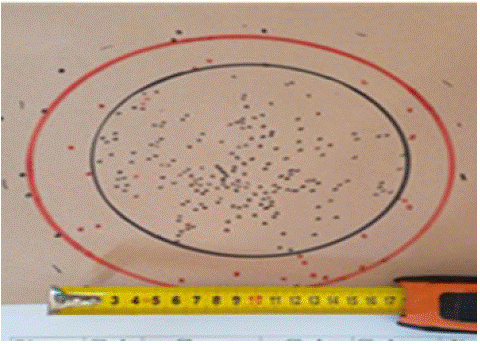
Figure 1: Shots from the same shotgun, same distance, same barrel choke, same circle diameter in the center of the shot and different number of Pellets of the central shot.
• Shots with the same number of pellets in the center of the shot can be fired from the same shotgun, from different shooting distances, using the same charge weight (Table 11 -Figure 2a,2b).
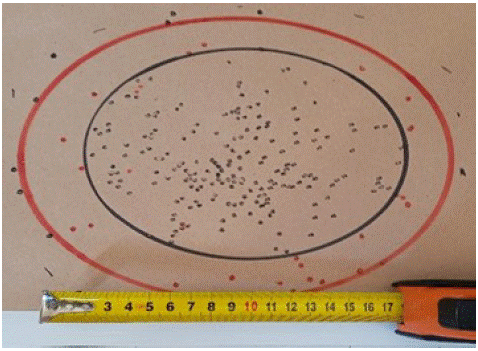
Figure 2a: Shots with the same number of pellets in the center of the shot, same charge (Weight and Νο Pellet), from different shooting distances.
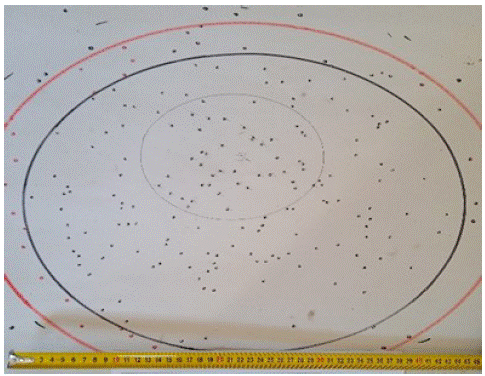
Figure 2b: Shots with the same number of pellets in the center of the shot, same charge (Weight and Νο Pellet), from different shooting distances.
• Shots from shotguns with the same barrel choke and with cartridges of different charge weights, may produce the same circle diameter at the center of the shot (Table 12 -Figure 3a, 3b). Shots from the same shotgun and from different shooting distances, may cause on a target surface, the same Circle diameter of the central shot, with the same number of pellets in the center of the shot, using the same shotshell charge weight (Table 13 -Figure 4a,4b). Τhe methodology for determining the firing distance, as presented and analyzed in this study, could be further enriched with tests and experimental results with shotguns of different caliber, fired at different distances, and using different type of shotgun shotshells. Therefore, future researchers could focus on carrying out the test shots from different shooting angles, as well as in different environmental conditions.
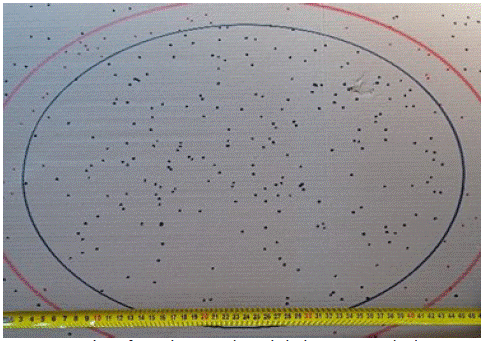
Figure 3a: Shots from the same barrel choke, same circle diameter of the central shot, same Νο Pellet and different Weight of charge.
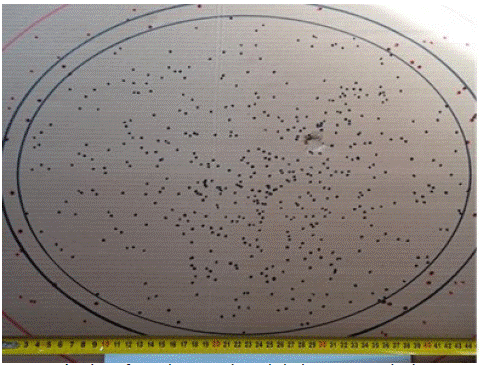
Figure 3b: Shots from the same barrel choke, same circle diameter of the central shot, same Νο Pellet and different Weight of charge.
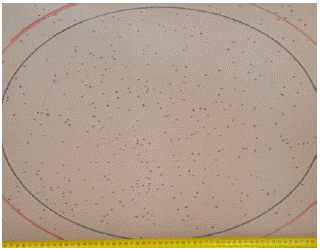
Figure 4a: Shots with the same diameter of the shot circle, same number of pellets in the center of the shot, same charge weight, same Shotgun Pellet Pattern (SPP), from different shooting distances.
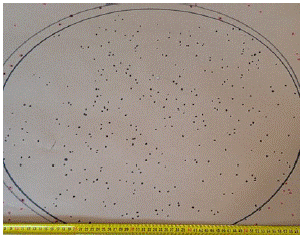
Figure 4b: Shots with the same diameter of the shot circle, same number of pellets in the center of the shot, same charge weight, same Shotgun Pellet Pattern (SPP), from different shooting distances.
Lastly, it should be noted that the current study comes with certain limitations, especially in regards to the area where the experimental shots were made.
References
- VJM Di Maio. Gunshot Wounds - Practical Aspects of Firearms, Ballistics, and Forensic Techniques. CRC Press, Boca Raton. 1993; 246–247.
- GJ Ordog, J Wasserberger, S Balasubramaniam. Shotgun wound ballistics. J Trauma. 1988; 28: 624-631.
- SS Das, RP Singh. Statistical Analysis of Cases Involving Shotguns with Incomplete Pellet Pattern, Indian Police J. 2005; 2: 58-65.
- Rios FG, Thornton JI, Guarino KS. Multivariate statistical analysis of shotgun pellet dispersion. Forensic Science International. 1986; 32: 21-28.
- Nag N, Sinha P. An investigation into pellet dispersion ballistics. Forensic Science International. 1992; 55: 105-130.
- Cakir I, Cetin G, Uner H, Albek E. Shot range estimation based on pellet distribution in shots with a pump-action shotgun. Forensic Sci Int. 203; 132: 211–215.
- Arslan M, Kar H, Üner B, Çetin G. Firing distance estimates with pellet dispersion from shotgun with various chokes, J Forensic Sci. 2011; 56: 988-92.
- Maitre M, Chiaravalle A, Horder M, Chadwick S, Beavis S. Evaluating the effect of barrel length on pellet distribution patterns of sawn-off shotguns. Forensic Sci Int. 2021; 320: 110685.
- Bartlett CS, Helfet DL, Hausman MR, Strauss E. Ballistics and gunshot wounds: Effects on musculoskeletal tissues. J Am Acad Orthop Surg. 2000; 8: 21–36.
- Karapirli M, Uysal C, Akcan R, Ercument M. The effect of targets on the spread of pellets from shotguns. Aust J Forensic Sci. 2015; 47: 355-362.
- Cail K, Klatt E. The effect of intermediate clothing targets on shotgun ballistics. Am J Forensic Med Pathol. 2013; 34: 348-51.